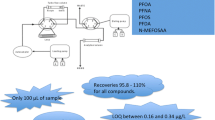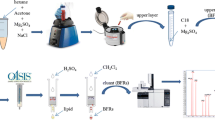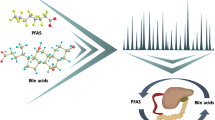Abstract
An automated high-throughput solid phase extraction (SPE) micro-elution method for 8 perfluorosulfonic acids, 11 perfluorocarboxylic acids and fluorooctane sulfonamide in human serum was developed. Importance was attached to the application of small volumes of reagents and solvents in addition to low sample volumes (50 μL) in order to save the highly valuable sample material for follow-up and other studies. Instrumental analysis was performed by ultra high pressure liquid chromatography coupled to triple quadrupole mass spectrometry (UHPLC-MS/MS). The recoveries of perfluoroalkyl substances (PFASs) were satisfactory and between 70 and 120 % for most of the compounds at the three investigated spike concentrations. Perfluorobutane sulfonate (PFBS) was slightly underestimated at high concentrations (20 ng/mL; 67 %), whereas perfluoropentanoate (PFPA), perfluorooctanoate (PFOA) and perfluorooctane sulfonate (PFOS) were overestimated with 134, 131 and 133 % respectively, at low spike concentrations (0.2 ng/mL). The precision of the method was below 20 % coefficient of variation (CV%) for all target compounds with the only exception of PFOS (22 %) at low spike concentrations. Method detection limits ranged from 0.006 to 0.34 ng/mL. High sensitivity, accuracy, repeatability and robustness have been demonstrated for an appropriate concentration range. The applicability for real samples was satisfactory demonstrated by analysis of 40 sera samples from the general population from Tromsø, Norway.




Similar content being viewed by others
References
Condor JM, Hoke RA, De Wolf W, Russell MH, Buck RC (2008) Are PFCAs bioaccumulative ? a critical review and comparison with regulatory criteria and persistent lipophilic compounds. Environ Sci Technol 42(4):995–1003. doi:10.1021/es070895g
Lau C, Anitole K, Hodes C, Lai D, Pfahles-Hutchens A, Seed J (2007) Perfluoroalkyl acids: a review of monitoring and toxicological findings. Toxicol Sci 99(2):366–394. doi:10.1093/toxsci/kfm128
Shaw S, Berger ML, Brenner D, Tao L, Wu Q, Kannan K (2009) Specific accumulation of perfluorochemicals in harbor seals (Phoca vitulina concolor) from the northwest Atlantic. Chemosphere 74(8):1037–1043. doi:10.1016/j.chemosphere.2008.10.063
Ahrens L, Barber JL, Xie ZY, Ebinghaus R (2009) Longitudinal and latitudinal distribution of perfluoroalkyl compounds in the surface water of the Atlantic Ocean. Environ Sci Technol 43(9):3122–3127. doi:10.1021/es803507p
Ahrens L, Shoeib M, Del Vento S, Codling G, Halsall C (2011) Polyfluoroalkyl compounds in the Canadian Arctic atmosphere. Environ Chem 8(4):399–406. doi:10.1071/en10131
Dreyer A, Matthias V, Weinberg I, Ebinghaus R (2010) Wet deposition of poly- and perfluorinated compounds in Northern Germany. Environ Pollut 158(5):1221–1227. doi:10.1016/j.envpol.2010.01.030
Dreyer A, Weinberg I, Temme C, Ebinghaus R (2009) Polyfluorinated compounds in the atmosphere of the Atlantic and Southern Oceans: evidence for a global distribution. Environ Sci Technol 43(17):6507–6514. doi:10.1021/es9010465
Stockholm convention. (2009) The Stocholm convention on persistent organic pollutants, Annex B. In: http://chm.pops.int/
European Parliament 2006
Paul AG, Jones KC, Sweetman AJ (2009) A first global production emission and environmental inventroy for perfluorooctane sulfonate. Environ Sci Technol 43(2):386–392. doi:10.1021/es802216n
USEPA (2006) 2010/2015 PFOA Stewardship program. In: http://www.epa.gov/opptintr/pfoa/pubs/stewardship/
Miljøverndepartementet (2013) FOR 2004-06-01 nr 922: Forskrift om begrensning i bruk av helse- og miljøfarlige kjemikalier og andre produkter (produktforskriften). In: http://www.lovdata.no/cgi-wift/ldles?doc=/sf/sf/sf-20040601-0922.html#2-32
Benskin JP, Phillips V, St Louis VL, Martin JW (2011) Source elucidation of perfluorinated carboxylic acids in remote alpine lake sediment cores. Environ Sci Technol 45(17):7188–7194. doi:10.1021/es2011176
Cai MH, Zhao Z, Yang HZ, Yin ZG, Hong QQ, Sturm R, Ebinghaus R, Ahrens L, Cai MG, He JF, Xie ZY (2012) Spatial distribution of per- and polyfluoroalkyl compounds in coastal waters from the East to South China Sea. Environ Pollut 161:162–169. doi:10.1016/j.envpol.2011.09.045
Huber S, Ahrens L, Bardsen BJ, Siebert U, Bustnes JO, Vikingsson GA, Ebinghaus R, Herzke D (2012) Temporal trends and spatial differences of perfluoroalkylated substances in livers of harbor porpoise (Phocoena phocoena) populations from Northern Europe, 1991-2008. Sci Total Environ 419:216–224. doi:10.1016/j.scitotenv.2011.12.050
Hanssen L, Dudarev AA, Huber S, Odland JO, Nieboer E, Sandanger TM (2013) Partition of perfluoroalkyl substances (PFASs) in whole blood and plasma, assessed in maternal and umbilical cord samples from inhabitants of arctic Russia and Uzbekistan. Sci Total Environ 447:430–437. doi:10.1016/j.scitotenv.2013.01.029
Lindh CH, Rylander L, Toft G, Axmon A, Rignell-Hydbom A, Giwercman A, Pedersen HS, Goalczyk K, Ludwicki JK, Zvyezday V, Vermeulen R, Lenters V, Heederik D, Bonde JP, Jonsson BAG (2012) Blood serum concentrations of perfluorinated compounds in men from Greenlandic Inuit and European populations. Chemosphere 88(11):1269–1275. doi:10.1016/j.chemosphere.2012.03.049
Ahrens L, Herzke D, Huber S, Bustnes JO, Bangjord G, Ebinghaus R (2011) Temporal trends and pattern of polyfluoroalkyl compounds in tawny owl (Strix aluco) eggs from Norway, 1986–2009. Environ Sci Technol 45(19):8090–8097. doi:10.1021/es103473v
Fei CY, McLaughlin JK, Lipworth L, Olsen J (2009) Maternal levels of perfluorinated chemicals and subfecundity. Hum Reprod 24(5):1200–1205. doi:10.1093/humrep/den490
Fei CY, McLaughlin JK, Tarone RE, Olsen J (2007) Perfluorinated chemicals and fetal growth: a study within the Danish National Birth Cohort. Environ Health Perspect 115(11):1677–1682. doi:10.1289/ehp.10506
Kristensen SL, Ramlau-Hansen CH, Ernst E, Olsen SF, Bonde JP, Vested A, Halldorsson TI, Becher G, Haug LS, Toft G (2013) Long-term effects of prenatal exposure to perfluoroalkyl substances on female reproduction. Hum Reprod 28(12):3337–3348. doi:10.1093/humrep/det382
Joensen UN, Veyrand B, Antignac JP, Jensen MB, Petersen JH, Marchand P, Skakkebaek NE, Andersson AM, Le Bizec B, Jorgensen N (2013) PFOS (perfluorooctanesulfonate) in serum is negatively associated with testosterone levels, but not with semen quality, in healthy men. Hum Reprod 28(3):599–608. doi:10.1093/humrep/des425
Lin CY, Wen LL, Lin LY, Wen TW, Lien GW, Hsu SHJ, Chien KL, Liao CC, Sung FC, Chen PC, Su TC (2013) The associations between serum perfluorinated chemicals and thyroid function in adolescents and young adults. J Hazard Mater 244:637–644. doi:10.1016/j.jhazmat.2012.10.049
Eriksen KT, Raaschou-Nielsen O, McLaughlin JK, Lipworth L, Tjonneland A, Overvad K, Sorensen M (2013) Association between plasma PFOA and PFOS levels and total cholesterol in a middle-aged danish population. Plos One 8 (2). doi:10.1371/journal.pone.0056969
Frisbee SJ, Shankar A, Knox SS, Steenland K, Savitz DA, Fletcher T, Ducatman AM (2010) Perfluorooctanoic acid, perfluorooctanesulfonate, and serum lipids in children and adolescents. Arch Pediatr Adolesc Med 164(9):860–869
Nelson JW, Hatch EE, Webster TF (2010) Exposure to polyfluoroalkyl chemicals and cholesterol, body weight, and insulin resistance in the general US population. Environ Health Perspect 118(2):197–202. doi:10.1289/ehp.0901165
WHO, State of the Science of Endocrine Disrupting Chemicals—2012. Switzerland, 2013
Haug LS, Thomsen C, Becher G (2009) A sensitive method for determination of a broad range of perfluorinated compounds in serum suitable for large-scale human biomonitoring. J Chromatogr A 1216(3):385–393. doi:10.1016/j.chroma.2008.10.113
Kuklenyik Z, Reich JA, Tully JS, Needham LL, Calafat AM (2004) Automated solid-phase extraction and measurement of perfluorinated organic acids and amides in human serum and milk. Environ Sci Technol 38(13):3698–3704. doi:10.1021/es040332u
Keller JM, Calafat AM, Kato K, Ellefson ME, Reagen WK, Strynar M, O’Connell S, Butt CM, Mabury SA, Small J, Muir DCG, Leigh SD, Schantz MM (2010) Determination of perfluorinated alkyl acid concentrations in human serum and milk standard reference materials. Anal Bioanal Chem 397(2):439–451. doi:10.1007/s00216-009-3222-x
Salihovic S, Karrman A, Lindstrom G, Lind PM, Lind L, van Bavel B (2013) A rapid method for the determination of perfluoroalkyl substances including structural isomers of perfluorooctane sulfonic acid in human serum using 96-well plates and column-switching ultra-high performance liquid chromatography tandem mass spectrometry. J Chromatogr A 1305:164–170. doi:10.1016/j.chroma.2013.07.026
Huber S, Haug LS, Schlabach M (2011) Per- and polyfluorinated compounds in house dust and indoor air from northern Norway—a pilot study. Chemosphere 84(11):1686–1693. doi:10.1016/j.chemosphere.2011.04.075
Lacina O, Hradkova P, Pulkrabova J, Hajslova J (2011) Simple, high throughput ultra-high performance liquid chromatography/tandem mass spectrometry trace analysis of perfluorinated alkylated substances in food of animal origin: milk and fish. J Chromatogr A 1218(28):4312–4321. doi:10.1016/j.chroma.2011.04.061
Chan E, Sandhu M, Benskin JP, Ralitsch M, Thibault N, Birkholz D, Martin JW (2009) Endogenous high-performance liquid chromatography/tandem mass spectrometry interferences and the case of perfluorohexane sulfonate (PFHxS) in human serum; are we overestimating exposure? Rapid Commun Mass Spectrom 23(10):1405–1410. doi:10.1002/rcm.4012
Berg V, Nøst TH, Huber S, Rylander C, Hansen S, Veyhe AS, Fuskevåg OM, Odland JØ, Sandanger TM (2014) Maternal serum concentrations of per- and polyfluoroalkyl substances and their predictors in years with reduced production and use. Environ Int 69:58–66. doi:10.1016/j.envint.2014.04.010
Nost TH, Vestergren R, Berg V, Nieboer E, Odland JO, Sandanger TM (2014) Repeated measurements of per- and polyfluoroalkyl substances (PFASs) from 1979 to 2007 in males from Northern Norway: assessing time trends, compound correlations and relations to age/birth cohort. Environ Int 67:43–53. doi:10.1016/j.envint.2014.02.011
Rylander C, Brustad M, Falk H, Sandanger TM (2009) Dietary predictors and plasma concentrations of perfluorinated compounds in a coastal population from Northern Norway. J Environ Public Health. doi:10.1155/2009/268219
Rylander C, Sandanger TM, Froyland L, Lund E (2010) Dietary patterns and plasma concentrations of perfluorinated compounds in 315 Norwegian Women: the NOWAC postgenome study. Environ Sci Technol 44(13):5225–5232. doi:10.1021/es100224q
Van Leeuwen SPJ, Karrman A, Van Bavel B, De Boer J, Lindstrom G (2006) Struggle for quality in determination of perfluorinated contaminants in environmental and human samples. Environ Sci Technol 40(24):7854–7860. doi:10.1021/es061052c
Gosetti F, Chiuminatto U, Zampieri D, Mazzucco E, Robotti E, Calabrese G, Gennaro MC, Marengo E (2010) Determination of perfluorochemicals in biological, environmental and food samples by an automated on-line solid phase extraction ultra high performance liquid chromatography tandem mass spectrometry method. J Chromatogr A 1217(50):7864–7872. doi:10.1016/j.chroma.2010.10.049
Calafat AM, Wong LY, Kuklenyik Z, Reidy JA, Needham LL (2007) Polyfluoroalkyl chemicals in the US population: data from the National Health and Nutrition Examination Survey (NHANES) 2003–2004 and comparisons with NHANES 1999–2000. Environ Health Perspect 115(11):1596–1602. doi:10.1289/ehp.10598
Haug LS, Thomsen C, Bechert G (2009) Time trends and the influence of age and gender on serum concentrations of perfluorinated compounds in archived human samples. Environ Sci Technol 43(6):2131–2136. doi:10.1021/es802827u
Brantsaeter AL, Whitworth KW, Ydersbond TA, Haug LS, Haugen M, Knutsen HK, Thomsen C, Meltzer HM, Becher G, Sabaredzovic A, Hoppin JA, Eggesbo M, Longnecker MP (2013) Determinants of plasma concentrations of perfluoroalkyl substances in pregnant Norwegian women. Environ Int 54:74–84. doi:10.1016/j.envint.2012.12.014
Acknowledgments
The authors appreciate the financial support from Helse Nord. The authors thank Sten-Kristian Odden for assistance during sample preparation and analysis and Ole-Martin Fuskevåg and Mikael Grönstad for introduction to the Tecan Freedom Evo 2000 system. The authors declare that they have no conflict of interest.
Author information
Authors and Affiliations
Corresponding author
Electronic supplementary material
Below is the link to the electronic supplementary material.
ESM 1
(PDF 725 kb)
Rights and permissions
About this article
Cite this article
Huber, S., Brox, J. An automated high-throughput SPE micro-elution method for perfluoroalkyl substances in human serum. Anal Bioanal Chem 407, 3751–3761 (2015). https://doi.org/10.1007/s00216-015-8601-x
Received:
Revised:
Accepted:
Published:
Issue Date:
DOI: https://doi.org/10.1007/s00216-015-8601-x




